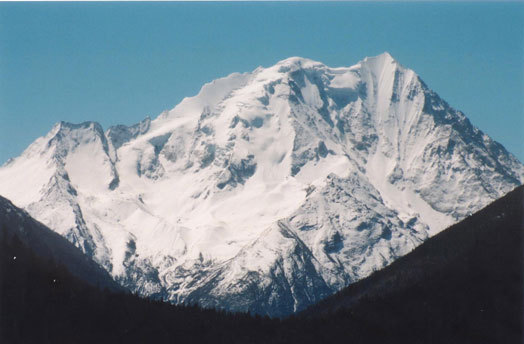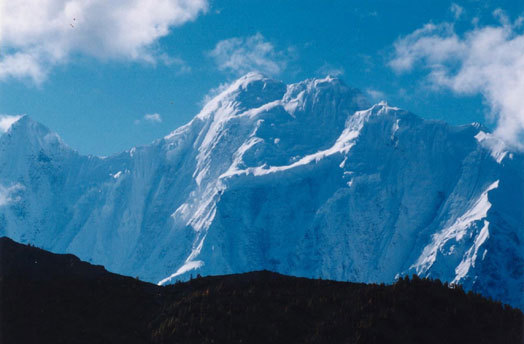
The north face of Haizi Shan (aka Yala, 5820m) in the Daxue Shan Range, Sichuan Province, China. The peak received its first official ascent in October 2006 by Malcolm Bass and Pat Deavoll. Though Charlie Fowler wrote that he and Christine Boskoff climbed “Yala” the same month, Deavoll reports that she came across no signs of the Americans during her expedition to the peak. [Photo] Tamotsu Nakamura
As reported in the NewsWire of November 16, Haizi Shan (aka Ja-ra or Yala–“the King of the Mountains”–5833m) in the northern Daxue Shan Range of China’s Sichuan Province had been the object of at least seven attempts before it received its first official (i.e., permitted) ascent this October, by the British mountaineer Malcolm Bass and the New Zealand alpinist Pat Deavoll. Among the mountains’ numerous suitors has been the peripatetic American Fred Beckey, who first tried the peak a number of years ago. Beckey returned with a team in early 2006 for another attempt, but members of his team were unable to improve upon the ca. 5700-meter high point reached in 2004 by Geoff Cohen and Dick Isherwood. Then in mid-October Bass and Deavoll managed the first ascent via a direct, ca. 1150-meter line up the north face.
In an email of October 25, Charlie Fowler had written a friend in Telluride, “We’re in Kangding, Sichuan, right now after a 10-day trip in the hills–we bagged a great peak, Yala–the one Fred Beckey and 10 other expeditions had failed to climb. Chris [Boskoff] and I walked in and did it by a great line.”
Despite the above correspondence, on December 18 Pat Deavoll wrote from New Zealand, “I know there was some suggestion [Fowler and Boskoff] were on or around Haizi Shan in October. Malcolm Bass and I arrived under the mountain on the north side on about the 2nd Oct and were there until the 21st (or thereabouts) but saw nothing of them and there was no talk of them from the local herders [with] whom we had a lot of contact…. “On December 22, she amended this with, One thing I got wrong…when I look back through my diary I see we actually left base camp on the 18th of October, arriving back in Kanding on the same day, and Chengdu on the 19th. There would have been time for Christine and Charlie to arrive under Haizi Shan just as we left, climb the mountain and return to Kanding within 7 or 8 days if they were acclimitised and had good weather.
Regardless of whether Fowler and Boskoff were on the same Yala as the one climbed by Bass and Deavoll, it is relatively certain that a few weeks later the Americans traveled to the unclimbed 6200-meter Genyen, in China’s Sichuan Province, November 9. Several files discovered on Fowler’s computer show that he next had a clear intention to head south to the Kang Karpo Range in the northwest corner of Yunnan province, perhaps to attempt an unnamed, 6509-meter peak two days’ hike from the village of Dechin.
According to the Japanese explorer Tamotsu Nakamura, who has almost singlehandedly brought the unclimbed peaks of the region to the attention of the world’s climbers, the virgin Peak 6509 (aka Meili Shue Shan II) that was mentioned repeatedly in Fowler’s computer files is the second-highest summit of the Kang Karpo Range. The Kang Karpo Range lies west of the village of Dechin, in the northwest corner of Yunnan province; the peak itself is located in Southeast Tibet.
The peaks of the Kang Karpo Range are considered holy to Tibetans; the highest of them, Kawa Gebo (aka Kawa Korpo, 6740m), is the highest in Yunnan Province, and nearly as sacred as Mt. Kailas. An overview of the peaks of the Kang Karpo Range can be found here. Like Kailas, Kawa Gebo is often circumambulated by Tibetans as part of a spiritual pilgrimage. Starting from Dechin, the ca. 300-kilometer circumambulation can take up to a month to complete, though it can be completed in ten days by a fast-moving party.

The west face of Peak 6509 (aka Meili Shue Shan II), Kang Karpo Range, in Southeast Tibet near Yunnan Province, China. Fowler and Boskoff would have seen the mountain on their 2002 circumambulation of the area; Fowler cited it as a potential objective in November 2006. The peak and the surrounding area is the one of the focus points for the search for the missing Americans. [Photo] Tamotsu Nakamura
Fowler and Boskoff had undertaken the circumambulation in 2002, completing it in twenty-four days–a relatively leisurely outing for such fit and experienced mountaineers. (In 2005, Bill McQuay, a reporter for National Public Radio, completed the trek in thirteen days; a map of the pilgrimage can be found here. Fowler and Boskoff had reportedly come away from their trek inspired by the number of climbing objectives they had seen. It is believed that they may have returned in November to attempt at least one of the peaks reconnaissanced on their 2002 journey.
According to the website SummitPost.org, at least one previous attempt on Kawa Gebo had met with tragedy. In 1991, a joint Sino-Japanese expedition had traveled to the region to attempt Kawa Gebo. “Tibetans in general believe it was blasphemous enough to tread on holy ground…,” notes the report on the website. “The monks at a local monastery felt offended by the fact that human beings were on the way to tread on holy ground and started an almost three week long prayer session in order to stop the attempt.” Team members were high on the main peak when it began to storm. On the descent to Camp III at 5100 meters, seventeen members of the expedition were killed, presumably in an avalanche–among the worst climbing accidents in the history of the region. Some of the bodies were not found until 1998.
Both Fowler and Boskoff are experienced mountaineers. Boskoff, since 1997 the owner and director of the guiding company Mountain Madness, has guided six of the so-called “Seven Summits,” the highest peaks on each continent. She has led or participated in twelve 8000-meter expeditions, summitting six times, including Lhotse (the first American woman to do so) and Everest (twice), and has established more than 100 rock routes in the Southwest United States. Fowler is one of the most prolific first ascensionists in the US, with nearly forty years of climbing experience to his credit. A fully certified rock guide, he has summitted two 8000-meter summits, Cho Oyu and Shishapangma. His two new routes on Peru’s Taulliraju (5830m) in the Cordillera Blanca are detailed in Alpinist Issue 7; his 1978 route on the Diamond, on Colorado’s Longs Peak–La Dolce Vita (V 5.8 A4), which he established with legendary Italian climber Renato Casarotto–appears in Issue 5. Photos and an essay by Fowler, written for Alpinist before the 2006 China trip, are currently being printed as part of Issue 19.